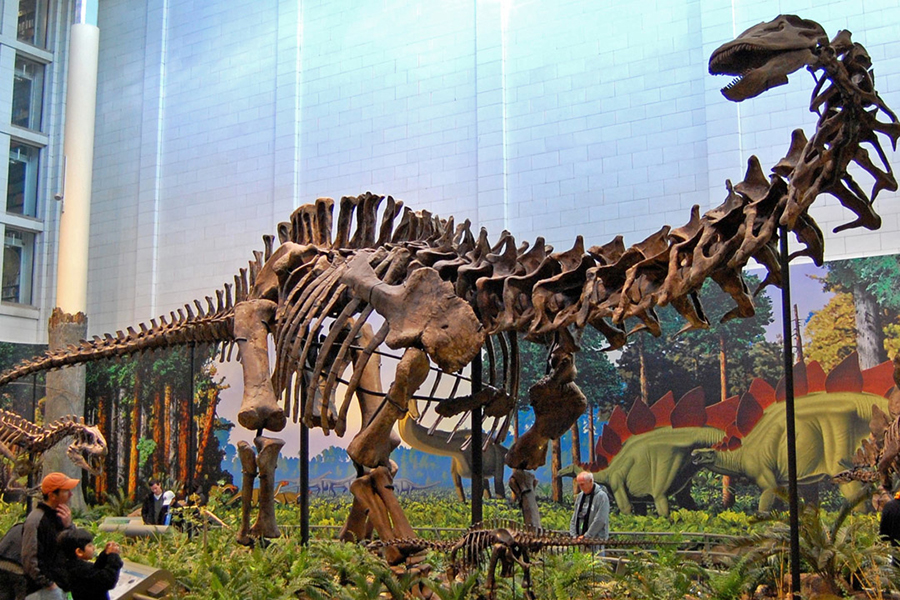Young Dinosaur Finding Hints At Evolutionary Differences

U of T researcher involved in study that uncovered rare diplodocid skull remains.
Diplodocids are a group of sauropods that include giants such as Diplodocus and Supersaurus — some of the longest creatures ever to walk the Earth.
Archaeologists have uncovered hundreds of fossils from this dinosaur group, but little is known about their origin or development into adult form.
In a study published in Scientific Reports, researchers including U of T PhD candidate Cary Woodruff analyzed a young diplodocid’s skull remains — unearthed in 2010 in Montana — and found that younger diplodocids may have had different diets than their older counterparts.
The skull remains, dubbed ‘Andrew,’ demonstrate that cranial dimensions did not develop on a fixed scale or at equal measures.
The dental and cranial differences between a mature and immature diplodocid can give the impression that they are of different species, but Andrew reveals that there are implications for cranial ecology as young diplodocids grow.
Woodruff and his team were able to determine specific differences between Andrew and adult skulls discovered earlier, including an extended tooth row, taller jaw bones, and peg tooth formation.
In fact, the authors state that if the fragments of the skull had been discovered separately, they would have likely been misidentified.
This is mostly because these distinct traits were common to other species — taxa — in the same clade as diplodocids, such as Eusauropoda and Macronaria. To a non-expert, it would seem strange that younger dinosaurs may horizontally integrate in taxa.
However, the researchers describe that this may be due to either recapitulation or, most likely, dietary niche partitioning between the young and adults.
Recapitulation theory suggests that an organism takes on forms of its ancestors — forms that were critical for survival in evolutionary past but are no longer needed — as it grows from embryo to adult, reaching the latest derived state during adulthood.
As such, it has been suggested that the skulls of adult diplodocids are taking the same form as their ancestors’.
The researchers in this study outline how dietary levels of specialization are what determined skull sizes, and that this is a form of recapitulation.
The younger diplodocids, like their relatives in the same clade and their common ancestors, ate more plants and lived in forested areas.
But as they got older, they gravitated to open space habitats and developed a more specific diet. Dietary specialization is the latest in the evolutionary timeline of diplodocid behavioural development, and is only found in fully mature individuals.
Woodruff explained why so many diplodocid skeletons have been discovered, but so little is known about their cranial ontogeny.
“The greatest difficulty in studying diplodocid — any sauropod — skulls are their rarity. We have loads of Diplodocus skeletons (well over 100), but fewer than 10 skulls are known. So it’s difficult to even have specimens to study in the first place,” he wrote.
The fragility of these fossils is also a significant limitation. “Dinosaur skulls are made up of dozens of thin, fragile, and delicate bones. The skull could easily get damaged or destroyed long before it’s even buried and begins the fossilisation process,” wrote Woodruff.
Some of Andrew’s bones were missing, “and those that remained were greatly squished” from being underground for millions of years. Bones can also become warped or distorted after long periods.
The work done by Woodruff and his team to draw out the cranial ontogeny and dietary habits of these animals have significant scientific implications. It reveals that diplodocid adults most likely gave birth and then separated from their young early on. It also shows us that herds were mostly segregated according to age.
The work done with Andrew highlights how the fossil record can impart indicators of behaviour and animal sociology. But the questions don’t end here.
“Andrew is not some missing link, nor does it fill in all of the remaining questions — it doesn’t even come close. Each new discovery, finding, and bit of research is like finding a piece to our puzzle. With every piece our picture becomes more and more complete,” wrote Woodruff.
Source: https://thevarsity.ca








